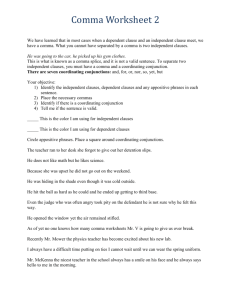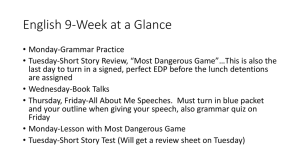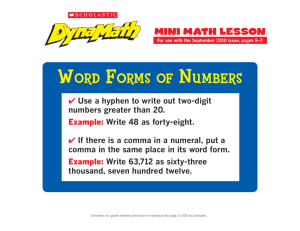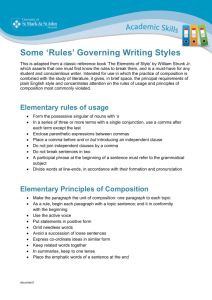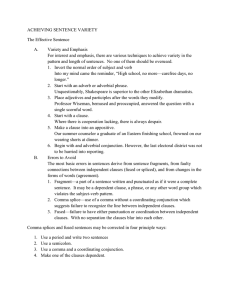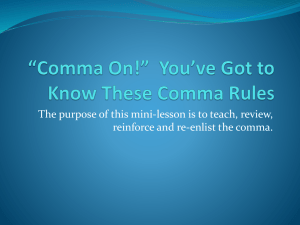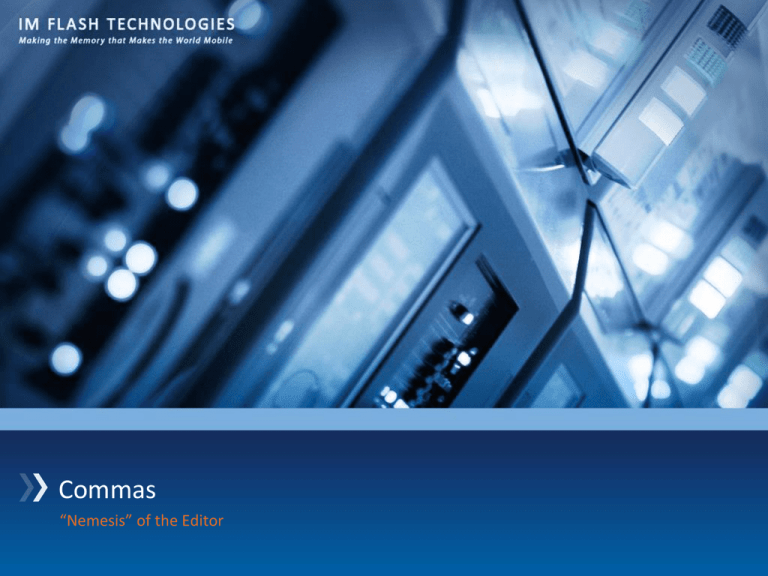
Commas
“Nemesis” of the Editor
Introduction
• The comma is the most widely used and most widely misused
punctuating mark. Although there are concrete rules for comma
usage, there are also exceptions to the rules. These exceptions are
used, mostly, for style. Luckily, because technical writing strips
writer of their style and personality, we don’t have to worry
about these exceptions .
• This presentation covers the main usage for the comma. There are
more in-depth rules in The Chicago Manual of Style (CMoS). If you
have any further questions, feel free to borrow my “orange
bible.”
CONFIDENTIAL
© 2009 IM Flash Technologies, LLC. All rights reserved.
Slide - 2
Introductory Phrases
• Introductory phrases are usually followed by a comma. As technical writers,
most of our sentences use adverbial phrases (modifies the verb of a
sentence). Adverbial phrases are also prepositional phrases. CMoS states that
“a single word or a very short phrase does not require a comma except to
avoid misreading.” I would recommend adding a comma based on cadence
(read the sentence out loud).
– Adverbial Phrases
Adverbial phrases answer the how, when, where, and why of a sentence.
– After cleaning the platen, attach the mounting ring to the source.
– Because of potential damage, only use DI water to wipe down any parts.
– In ETI, log the tool to the IN_REPAIR state. [Note that CMoS may not require a comma here.]
– Participial Phrases (rarely used in our documentation)
Participial phrases modify the noun of a sentence and start with a verb ending in ed or
ing.
– Having attended the comma presentation, James decided to discontinue his TW meeting
attendance.
– Exhausted by the TW meeting, James decided to take the rest of the day off.
CONFIDENTIAL
© 2009 IM Flash Technologies, LLC. All rights reserved.
Slide - 3
Restrictive and Nonrestrictive phrases
• Restrictive Phrases: Essential to the meaning of the sentence.
• Nonrestrictive Phrases: Not essential to the meaning of the
sentence.
– Incorrect: Wipe down the platen as necessary.
– Correct: Wipe down the platen, as necessary.
– Correct: Click the red Exit button, which is located in the top right corner.
– Correct: Click the red Exit button that is located in the top right corner.
– Correct: This book is dedicated to my wife Betty.
– Correct: This book is dedicated to my wife, Betty.
CONFIDENTIAL
© 2009 IM Flash Technologies, LLC. All rights reserved.
Slide - 4
Serial Commas/The “Oxford” Comma
• The Chicago Manual of Style recommends use of the serial comma (i.e., a
comma precedes the final item in a series). This is a commonly disputed
convention because AP Style (e.g., newspapers, magazines, etc.) does not
use the serial comma.
– Incorrect: For all fab emergencies, page area leadership, the tool owner and the
sustaining group lead.
– Correct: For all fab emergencies, page area leadership, the tool owner, and the
sustaining group lead.
• The serial comma is preferable for cadence (how the sentence reads).
However, using the serial comma and not using the serial comma can both
lead to ambiguity because of apposition. Remember the following rule:
– x, y, and z is unambiguous if y cannot be read as an apposition to x.
CONFIDENTIAL
© 2009 IM Flash Technologies, LLC. All rights reserved.
Slide - 5
Independent Clauses
• Independent clause: Can stand alone as a single sentence. Must have a
subject and a verb. When two independent clauses are joined by a
coordinating conjuctions (for, and, nor, but, or, yet, so), a comma
precedes the coordinating conjunction (F.A.N.B.O.Y.S.).
– Correct: I went to the store, and my brother stayed at home to sleep.
– Correct: Candy is dandy, but liquor is quicker.
• Note that in our documentation we use the imperative mood (command
form). In the imperative mood, the subject is intended though not
outright stated. Imperative clauses are still considered independent
clauses (therefore “shut up” can be considered a complete sentence).
– Correct: Click the OK button, and close the application.
– Correct: Restart the computer, or reset the program.
CONFIDENTIAL
© 2009 IM Flash Technologies, LLC. All rights reserved.
Slide - 6
Dependent Clauses
• Dependent clauses cannot stand alone as a sentence. When a
dependent clause precedes an independent clause, it is followed by a
comma.
– Correct: If the FOUP is damaged, remove the wafers using a wafer wand.
But
– Correct: Remove the wafers using a wafer wand if the FOUP is damaged.
• A dependent clause that follows a main clause does not require a
comma (unless it is non-restrictive). Nonrestrictive dependent clauses
are rarely used in technical writing (for concision). Nonrestrictive
dependent clauses can be deleted without changing the meaning or
intention of the sentence.
– She ought to be promoted, if you want my opinion.
– The tool did not run today, because we were too lazy to operate it.
CONFIDENTIAL
© 2009 IM Flash Technologies, LLC. All rights reserved.
Slide - 7
Compound Predicate
• Compound predicate: one independent clause in which one
subject governs two verbs. No comma is needed before the
coordinating conjunction (unless to avoid confusion or break up a
very long sentence).
– Correct: This energy isolation procedure (EIP) identifies the maintenance
hazards for the Airgard Cyclone Fume abatement tools and provides
instructions for controlling those hazards.
– Incorrect: This energy isolation procedure (EIP) identifies the maintenance
hazards for the Airgard Cyclone Fume abatement tools, and provides
instructions for controlling those hazards.
– Correct: The source housing may be coated with phosphorus residue and may
contain arsenic contamination.
– Incorrect: The source housing may be coated with phosphorus residue, and
may contain arsenic contamination.
CONFIDENTIAL
© 2009 IM Flash Technologies, LLC. All rights reserved.
Slide - 8
© 2009 IM Flash Technologies, LLC. All rights reserved. Products are warranted only to meet the applicable production data sheet specifications.
Information, products and/or specifications are subject to change without notice. All information is provided on an “AS IS” basis without warranties of any kind. Dates are estimates only.
Drawings may not be to scale. All trademarks are the property of their respective owners.


